Colonial Origins
In the mid-seventeenth century, the area known today as Suriname was settled by the British from Barbados, who began shipping Africans to Suriname as slaves to work on their plantations. At the Peace of Breda in 1667, ending the Second Anglo-Dutch War, Suriname was relinquished to the Dutch, and English settlers withdrew. Dutch plantation owners followed in the footsteps of the English and continued the importation of African slaves into the nineteenth century. The English and Dutch colonists brought some 325,000 Africans, collectively, to Suriname between 1650 and the early nineteenth century. Most of these slaves came from the territories that are today the nations of Ghana, Togo, Benin, Nigeria, and the region around the mouth of the Congo.
From the very beginning of the slave trade to Suriname, rebels fled their plantations to escape the cruel treatment by the European colonists. Most of the plantations were situated near the coast, so the runaways headed up the rivers to the lush jungles of the interior. The adjustment to this new environment was difficult compounded by massive efforts by the government and plantation owners to recapture and kill escaped slaves, but Maroon groups preserved and created cultures of remarkable complexity, drawing on their diverse African heritages.

Maroon Art
Historical literature on Maroon art has often portrayed it as a direct offshoot of African culture transplanted in the New World. However, the variety of Maroon artistic forms has evolved greatly over the past one hundred and fifty years as it was passed from one generation to the next. Some of these changes have been in the materials, precise techniques, or the different motifs and patterns used. Early Maroons came from a wide range of cultural and artistic backgrounds that shared a certain cultural orientation, which, from a broad art historical perspective, shares key aspects in common with West and Central African artistic modes, but which has changed and evolved to become unique to the Maroon people today.
Since they first established villages in the jungles, Maroon men have worked in wood. They used tools like axes and machetes imported from the coast to build houses, canoes, stools, and cooking utensils, and these early forms had little or no decorative embellishments. As the art of wood carving developed, new and striking styles emerged that built upon traditional styles, while shifting to meet the demands of the true connoisseurs for whom these carvings were gifts -- lovers and potential wives.
Textile arts followed a similar stylistic evolution as woodcarving. Early textiles served practical purposes and eventually developed into elaborate decorative sewing, usually in garments made for men as gifts. Increases in the supply of trade cotton also caused dramatic shifts in textile production including the development of embroidery patterns, appliqué, and patchwork patterns in a wide range of colors and styles.
Originally, calabash decoration was done only on the exterior side of the shell and used geometric shapes very similar to those used in African calabash carvings. As new art forms developed, calabash carving experienced a revolution as artists began using the interior surface of the fruit, as well as the outside. To carve the inside, artists used a piece of broken glass in place of a knife or chisel. Calabash carving is one of the few arts that both men and women would perform, though men often carved the outside, and women the inside of the fruit. Over time regional styles were established with only minor changes in what has become a stable stylistic mode.
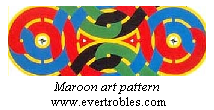
Recent History
Today, the traditional Ndyuka way of life is being replaced with modern and commercial amenities and products. Commercialization and modernization have, in the past century, greatly influenced many of the cultural traditions that were forged three hundred years ago.
Since the 1970s, Ndyuka art has become more specialized and commercially-oriented. The elaborate woodcarvings made by Ndyuka men, traditionally made as gifts for their women, are now produced with lesser quality to sell in the capital city of Paramaribo, or in French Guiana, mainly to tourists. Inversely, a modern Ndyuka man will often import trade goods from Paramaribo to give to his wife, in lieu of making them himself. Today, women depend on their kitchenware and other basic necessities on imported manufactures far more than on woodcarvings made by their husbands.
Traditionally, the main garment for Ndyuka women was a pangi, a one-piece wrap-around cloth that covered the body from waist to knees, and was often accompanied by a cotton cape or home-sewn bra. Today the women are more conservative in covering their bodies and often wear a commercial bra or sleeveless blouse. This exposure to city life in Paramaribo has clearly affected not only the artistic preferences, but also altered the self-perception of the Ndyuka people and induced a desire to conform to contemporary social customs.
Ndyuka religion, too, has been affected by globalization. Missionaries introduced Christianity, in addition to other world religions, to Ndyuka society. Today there are an estimated 3,000 Ndyuka Christians, who, in addition to completely changing their religious beliefs, often move out of the village because they are considered by others to be a threat to the Ndyuka way of life.
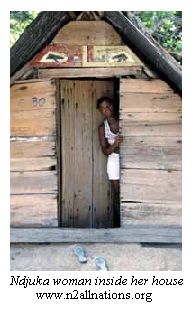 Marriage and Family Life
Marriage and Family Life
The Ndyuka kinship system is polygamous and matrilineal, which shapes their social organization and customs. A man generally has two to three wives, in addition to lovers, or potential wives. A husband maintains his wives’ affections by giving handcrafted gifts, most commonly in the form of woodcarving, hunting and fishing for her, clearing gardens in the forest, and constructing houses and canoes. The wives reciprocate these gifts with clothing such as breechcloths, capes, shirts, and handkerchiefs in extraordinary patchwork patterns and spiral motifs.
In Ndyuka society, husbands and wives do not live together, and in fact, each person may have two to three residencies. One house may be in the village where family and business affairs, as well as social rituals and customs, are performed. Another house may be in a camp several miles away, where social regulations are more relaxed and many feel the camps hold a more romantic atmosphere. In following a matrilineal custom, when a father passes away, the mother’s oldest male relative, brother, or uncle, takes the father’s place as the head of the family.
Traditionally, girls were ready to be married by their mid-teen years, and were sometimes betrothed from birth. Most marriages, however, were (and are) based on romantic attraction between the spouses. Most Ndyukas were fairly casual with their sexual relationships, both before and after marriage, and sex was not necessarily associated with marriage. “Divorce” was common practice.
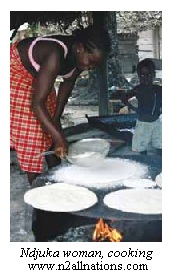 Gender Roles
Gender Roles
Ndyuka women are responsible for growing food, cooking, sewing clothes, making cookware. Children live with their mother for the first few years, and then a male child may be given to a father or uncle to be raised into adulthood. Although Ndyuka society is matrilineal, it is not matriarchal. This means that although the family lines follow the mother’s side, women do not hold the most power in social situations. The mother’s or grandmother’s brothers have the most authoritative power, and children inherit their property and title from them. Not only are women the recipients of beautifully ornate wooden handicrafts, they are also critics and connoisseurs. Women are also responsible for making ornately carved calabash spoons and dishes, as well as textiles embellished with embroidery, patchwork, and appliqué.
When a woman receives a woodcarving from a man, she is expected to reciprocate the gift of love with artwork of her own. Cloth and thread imported from the coast have long provided materials for the production of beautiful shoulder capes, breechcloths, and other men’s garments.
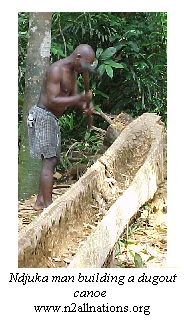 The fruit of the calabash tree provides another artistic material for women. At first it was men who decorated the bowls and covered containers made from them, incising their designs on the fruit’s exterior surface with woodcarving tools such as compasses and chisels. But then women began experimenting with the interior surface of these same objects, carving designs with small pieces of broken glass. Today, calabash carving is almost exclusively a women’s art.
The fruit of the calabash tree provides another artistic material for women. At first it was men who decorated the bowls and covered containers made from them, incising their designs on the fruit’s exterior surface with woodcarving tools such as compasses and chisels. But then women began experimenting with the interior surface of these same objects, carving designs with small pieces of broken glass. Today, calabash carving is almost exclusively a women’s art.
Ndyuka men are responsible for fishing and hunting, housing and canoe manufacture, decorative woodcarving, and felling trees in forest areas being cleared for gardens. They must also periodically spend time on the coast engaged in wage labor in order to earn money so that they can buy necessary goods such as cloth, tools, kitchenware, and other western manufactures. Traditionally, all men were taught how to carve beautiful wooden objects. Men’s relationships with women are in part dependent on their abilities as artists. A man who was not skilled as a carver is at a disadvantage when it comes to impressing a lover or wife.
Subsistence
Agriculture is a major aspect of Ndyuka society and economy. The main crop is cassava, with rice being the next most important staple. Other crops include taro, yams, okra, maize, plantains, bananas, sugar cane, and peanuts. There are no markets in Ndyuka villages, so these crops are not traded or sold. The fruits of the calabash tree are particularly important to the Ndyuka because they are used for making spoons and dishes.
Hunting and fishing are also important forms of subsistence in Ndyuka society. With villages primarily located along rivers, fishing is the most common and convenient source of food. There are several different techniques used for catching fish. Fishing with fish drugs was a special technique that was taught to the Ndyuka by the Amerindians. The nekku plant was beaten to a pulp by the side of the river, and the juice from the pulp drugged the fish in the water. The apparently lifeless fish would float to the surface and could then be collected with a net or shot with arrows. Other techniques include bow and arrow, traps, and baited hooks. Ndyuka men hunt a wide variety of tropical forest animals including a variety of birds, monkeys, tapirs, deer, opossums, sloths, otters, and peccaries.


Tribal Organization
The various Maroon peoples of Suriname have their own independent governments and established territories. The headman of each tribe is called the granman. The granman is appointed in accordance with his matrilineal inheritance; when a granman dies, he is succeeded by a close matrilineal relative, such as a sister’s son, while his own sons never inherit the title. These granmans are officially recognized by the Surinamese government.
The Ndyuka people are divided into 14 clans, or lo. Each lo is subdivided into family groups, called bee, related through the female line. The Ndyuka share these organizational elements with the other Suriname Maroon peoples.
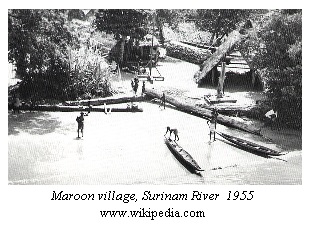
Spirituality
Ndyukas have always devoted massive amounts of time, energy, and resources to rituals of various sorts. Even decisions like where to clear a garden, build a house, or whether to make a trip, are made in consultation with village deities and ancestors' spirits. The means of communicating with these entities vary, from spirit possession and the consultation of oracle bundles, to the interpretation of dreams. Gods and spirits, who are a constant presence in daily life, are also honored through frequent prayers, libations, feasts, and dances. Lifecycle events like birth, maturation, and death are handled through extensive rituals, with feasts, music, and performances representing and evoking forest spirits, snake gods, and other powers.
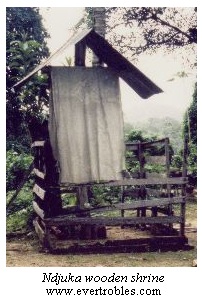 The concept of the soul is important in Ndyuka spirituality. It is believed that each person, animal, and thing has a soul as well as a spirit. According to the Ndyuka belief, human beings have an akaa (an unchanging, essential spirit), a soul, and a body. There are two worlds in which the akaa and the soul cycle through: the visible world, the world of the living; and the invisible world, the world of the ancestors. Ndyuka believe that a new life originates from the invisible world of the ancestors, lives and dies in the visible world, and then returns to the invisible world as an ancestor. If an individual has led a good life, his or her soul returns once again to the visible world as an infant. This reincarnation is called nenseki. The Ndyuka are careful not to do anything to anger the spirits. Charms, amulets, and fetishes are used to protect them from evil.
The concept of the soul is important in Ndyuka spirituality. It is believed that each person, animal, and thing has a soul as well as a spirit. According to the Ndyuka belief, human beings have an akaa (an unchanging, essential spirit), a soul, and a body. There are two worlds in which the akaa and the soul cycle through: the visible world, the world of the living; and the invisible world, the world of the ancestors. Ndyuka believe that a new life originates from the invisible world of the ancestors, lives and dies in the visible world, and then returns to the invisible world as an ancestor. If an individual has led a good life, his or her soul returns once again to the visible world as an infant. This reincarnation is called nenseki. The Ndyuka are careful not to do anything to anger the spirits. Charms, amulets, and fetishes are used to protect them from evil.
Religious imagery mainly consists of simple shrines and wooden figurines. Shrines are built along the rivers in the village, and usually consist of a tall pole with few offerings, including shells, bottles, food, and drink, at the base. Prayers are spoken at the shrines, both for aid and thanksgiving, to the gods and spirits and ancestors. Most shrines are not dedicated to a specific god or spirit, but are devotional places for all of the deities and ancestors. Religious carvings are generally simple, geometrically-shaped figures, and are crudely made. This style of carving appears to be a completely independent art from the more elaborate, secular woodcarvings.

